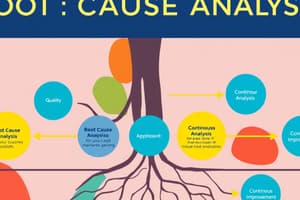Podcast
Questions and Answers
What primary focus does Root Cause Analysis (RCA) have when investigating adverse events?
What primary focus does Root Cause Analysis (RCA) have when investigating adverse events?
RCA primarily focuses on systems and processes involved in the adverse event, rather than on individual performance.
Describe the importance of immediacy in initiating a Root Cause Analysis investigation.
Describe the importance of immediacy in initiating a Root Cause Analysis investigation.
Immediate initiation of RCA investigations is crucial because evidence may disappear and involved individuals may forget details over time.
What is the purpose of the 'Five Whys' technique in root cause analysis?
What is the purpose of the 'Five Whys' technique in root cause analysis?
The 'Five Whys' technique helps drill down to the root cause of an issue by repeatedly asking 'why' to uncover underlying problems.
List two examples of risk control treatments implemented for loss prevention after identifying a root cause.
List two examples of risk control treatments implemented for loss prevention after identifying a root cause.
What caution should be taken regarding the classification of 'training' as a root cause?
What caution should be taken regarding the classification of 'training' as a root cause?
Flashcards
Root Cause Analysis (RCA)
Root Cause Analysis (RCA)
A structured investigation to find the fundamental reason for problems, focusing on systems and processes.
Identifying Root Causes
Identifying Root Causes
Gathering information from involved parties & process mapping to reveal underlying issues.
Risk Control Treatments
Risk Control Treatments
Strategies implemented to decrease the likelihood of future problems, like staff training and procedure revisions.
Verification of Effectiveness
Verification of Effectiveness
Signup and view all the flashcards
RCA Documentation
RCA Documentation
Signup and view all the flashcards
Study Notes
Root Cause Analysis (RCA)
- A structured study aimed at uncovering the underlying cause of adverse or non-conforming events (NCEs), including near misses.
- Focuses on systems, processes, and common causes to enhance safety and prevent recurrence.
- Immediate investigation is crucial when patient safety is compromised; delay can lead to loss of evidence and poor recall.
Identification of Root Causes
- Root causes can be challenging to identify; initial solutions may not address the actual problem.
- Effective tools include:
- Interviews to gather insights from those involved.
- Process analysis using flow charts, cause-and-effect diagrams, and the “Five Whys” technique.
- RCA emphasizes systemic issues over individual performance.
Risk Control and Loss Prevention
- After identifying risks, strategies are developed to prevent future occurrences.
- Examples of risk control treatments:
- Staff education to enhance skill sets.
- Procedure revisions and policy reviews to ensure compliance with best practices.
Common Root Causes
- Possible root causes include:
- Lack of training or incomplete training initiatives.
- Flaws in process design and change control issues.
- Inadequate Standard Operating Procedures (SOPs) and purchasing quality concerns.
- Ignored quality control trends or outliers and lack of documentation.
- Insufficient maintenance of instruments.
Implementation of Action Plan
- Action plans should be proportional to the severity of the identified problem.
- Careful planning is necessary to ensure effective change.
- Plans must include documentation changes, process modifications, training requirements, and monitoring mechanisms.
- Clear accountability for tasks and expected outcomes should be established.
Verification of Effectiveness
- Necessary to ensure that implemented action plans are effective in preventing recurrence.
- Mock run-throughs of changes can help verify expected outcomes.
- Key measures of improvement must be identified to ensure that changes do not adversely affect service/product quality.
Evidence for Verification
- Authentic and objective documentation is vital for verifying effectiveness.
- Evidence may include:
- Procedure documents and service records.
- Customer feedback and employee interviews.
- Training and competency records showing understanding of new processes.
Reasons for Verification Failure
- Verification may fail due to:
- Incomplete or inaccurate description of the non-conformity.
- Rash problem-solving with lack of cross-functional team involvement.
- Poor communication and misidentification of root causes.
- Insufficiently implemented corrective actions and lessons learned review.
Importance of Communication
- Ongoing communication is critical throughout the NCE management process.
- Information regarding quality issues must reach those responsible promptly and clearly.
- Transparency about investigation processes can enhance staff cooperation and reduce resistance.
Management Review
- Management must be informed of problems and corrective actions taken to address NCEs.
- Communication should cover major impacts, trends, and improvements in quality management systems (QMS).
- Resource allocation should be adjusted as necessary to meet customer and regulatory standards.
Documentation Requirements
- Comprehensive documentation is required across all stages of the corrective action process, including:
- Initial reporting, investigation, and analysis.
- Implementation and validation of actions, as well as training.
- Ongoing communication and management reviews.
- Proper documentation is essential to meet regulatory compliance and facilitate inspections.
Studying That Suits You
Use AI to generate personalized quizzes and flashcards to suit your learning preferences.





